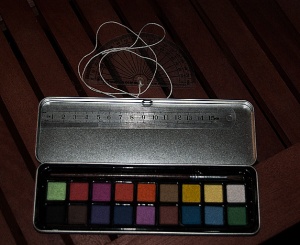Field Sketching was originally a military skill developed to a fine art in the 18th and 19th Centuries.
In a time of hit-and-miss topographic mapping, field panoramic sketches drawn/painted from a known point on the map were invaluable for allowing officers to visualise the terrain they would be working in. With the advent of portable photographic equipment and aerial photography in particular in the early 20th Century, it started to become obsolete as a military skill. By the end of the 2nd World War, the fine art of field sketching had all but died out, although it has continued to be used by snipers, intelligence personnel and special forces to a far lesser degree.

A stunning WWI-era military panoramic field sketch in watercolour painted by a member of the New Zealand Expeditionary Force in Palestine in 1917. Image courtesy NZ Government Archives.
Field sketches were drawn and sometimes were painted in order to illustrate subtle details and changes in vegetation and terrain. Destined to be used once and then discarded, it’s a miracle that any of these field sketches have survived the rigours of time and neglect. We’ll cover the actual art of field sketching in a later post.
To bring the lost art of field sketching back to life, it all starts with the equipment. In this case, a Field Sketching Outfit. Inspired by expeditionary artist Maria Coryell-Martin’s field-appropriate Art Toolkit (http://expeditionaryart.com/shop/product/art-tool-kit/) and knowing a little bit about the methodology of military field sketching from various 19th and early/mid 20th Century manuals on the subject, I have put together a period-style field sketching outfit.

Field Sketching Outfit with its accouterments – a compass and case, field glasses and mini-tripod. Mini-tripod is entirely optional.
The outfit is based on an Australian-made 1943 vintage No. 2 Mk.I General Service map case and it’s turned out to be the perfect size for this purpose.
Inside the map case cover are sewn loops and pockets which now contain the following:
- Tin of watercolour paints
- Vintage celluloid protractor with string
- 6-inch metal ruler
- 3 x assorted brushes
- An HB pencil
- A 2B pencil
Clipped to the map board are the following:
- A cello bag containing a small supply of general purpose paper towels
- A field message notebook – contains gridded pages which are great for noting down fine detail before transferring to the paper
- An A5 spiral-bound book of 30 pages of watercolour/sketch paper
An acetate map overlay sheet covers and protects the paper when the case is closed up. On the back of the map board has been fitted a jury-rigged tripod mount for use with a standard photographic tripod, or in this case, with an Ultrapod II compact tripod spraypainted green. This allows the case’s map board to be mounted as a plane table for sketching and watercolour painting. I find working with the outfit on my lap while I’m sitting to be the most comfortable method in the field, but a tripod mount gives some more options.
Other equipment used with the outfit includes:
- Prismatic Compass with case and lanyard
- Map
- Field Glasses
- Mini Tripod (optional, but useful for OP work)
- Shoulder strap
Next post in this series will cover the methodology behind an accurate field sketch.




You must be logged in to post a comment.